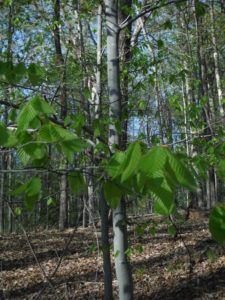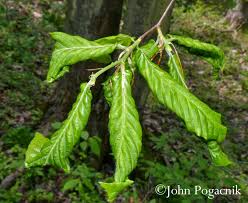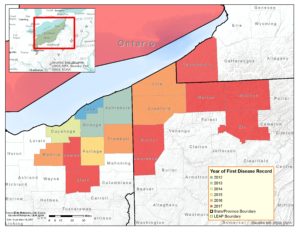beech leaf disease symptoms; photo by John Pogacnik, Lake Metroparks
In 2012, Ohio authorities detected a new disease attacking American beech (Fagus grandifolia) in northeast Ohio. The disease has spread to several counties in northeast Ohio and neighboring areas of Pennsylvania, New York, and Ontario.
Counties currently reporting beech leaf disease; Cleveland Plain Dealer relying on data from Ohio Department of Natural Resources
Currently, no cause has been determined – despite efforts by the USDA Forest service, Ohio Division of Forestry, Ohio Department of Agriculture, Holden Arboretum, and Ohio State University.
Early symptoms are dark striping on the leaves – best seen by looking upward into the backlit canopy. The striping is formed by a darkening and thickening of leaf tissue between leaf veins. Later, lighter, chlorotic striping may also occur. Both fully mature and very young “emerging” leaves show symptoms. Eventually the affected foliage withers, dries, and yellows. Bud and leaf production is also affected. However, there is little premature leaf loss.
All ages and sizes of beech are affected. Sapling and pole-sized trees die within about three years after symptoms are observed. In areas where the disease is established, the proportion of American beech affected nears 100%.
Disease incidence does not appear to be influenced by slope, aspect, or soil conditions. Also, while a wide variety of insects and pathogens is associated with symptomatic trees, these appear to be separate from and unrelated to beech leaf disease.
The disease might also affect European and Asian beech.
Given the range and ecological importance of American beech – a species already under threat in from beech bark disease – scientists seek to form a collaborative group that would efficiently address research issues related to the cause of this malady and management implications for the species.
Beech trees in the Northeast, Appalachians, and even Michigan are already under threat from beech bark disease, described here .
Workshop to Coordinate Research and Management
A workshop will take place May 2-3, 2018 at Cleveland Metroparks Watershed Stewardship Center, 2277 West Ridgewood Drive, Parma, OH 44134
Presentations on the first day of the meeting would seek to
- Prioritize next steps and coordinate efforts.
- Increase communication and coordination among land managers and researchers.
- Inform resource allocation and leverage funding sources for maximum effectiveness.
- Set up 5-year plan – Research, Survey, Diagnostics, etc.
The second day would include a field trip to view the disease.
Contact one of the following if you are interested in giving a presentation on the ecological importance of beech; or the history, etiology, surveys, or epidemiology of beech leaf disease.
- James Jacobs (jamesjjacobs@fs.fed.us)
- Connie Hausman (ceh@clevelandmetroparks.com)
- Danielle Martin (dkmartin@fs.fed.us)
- John Pogacnik (jpogacnik@lakemetroparks.com)
 healthy beech in Virginia; F.T. Campbell
healthy beech in Virginia; F.T. Campbell
SOURCES
http://portal.treebuzz.com/beech-tree-leaf-disease-no-known-cause-1036
John Pogacnik, Biologist, Lake Metroparks & Tom Macy, Forest Health Program Administrator, Ohio Department of Natural Resources Division of Forestry. Forest Health Pest Alert Beech Leaf Disease July 2016


Beech trees of all sizes on my 1.5 acre property in ct seem to have dry curling leaves , last year they all seemed healthy. I am 1 mile inland of long island sound, half mile north of I-95
Beech leaf disease is now found almost throughout Connecticut. Compare your trees’ leaves to photos on the website of the Connecticut Agriculture Experiment Station.